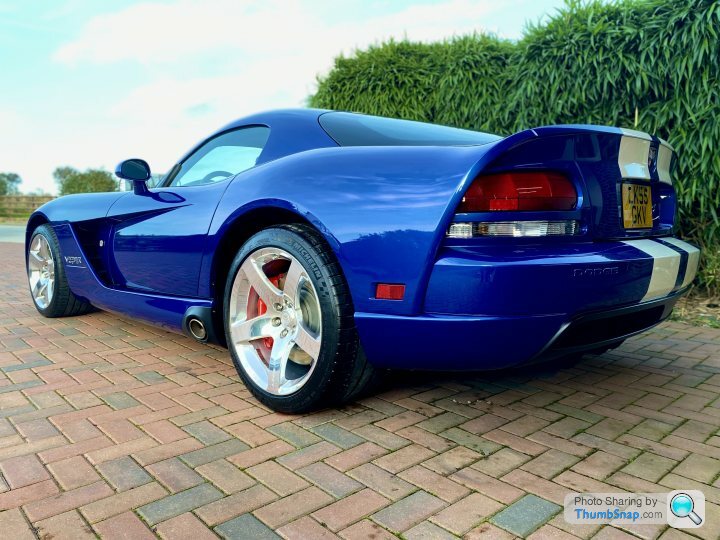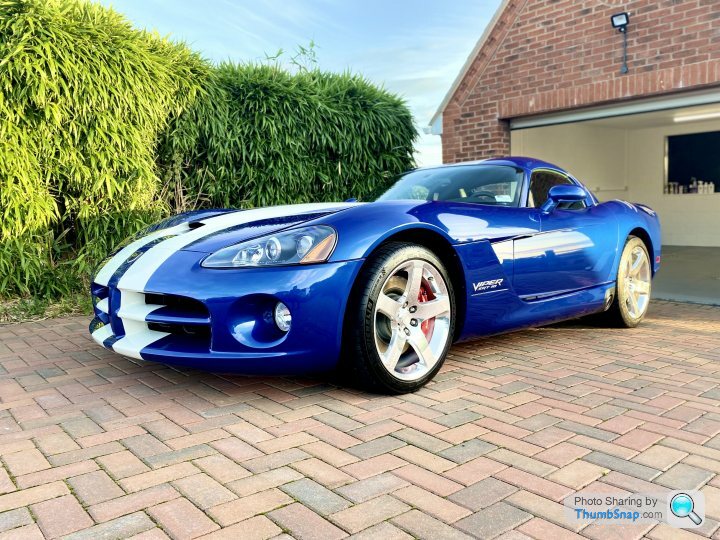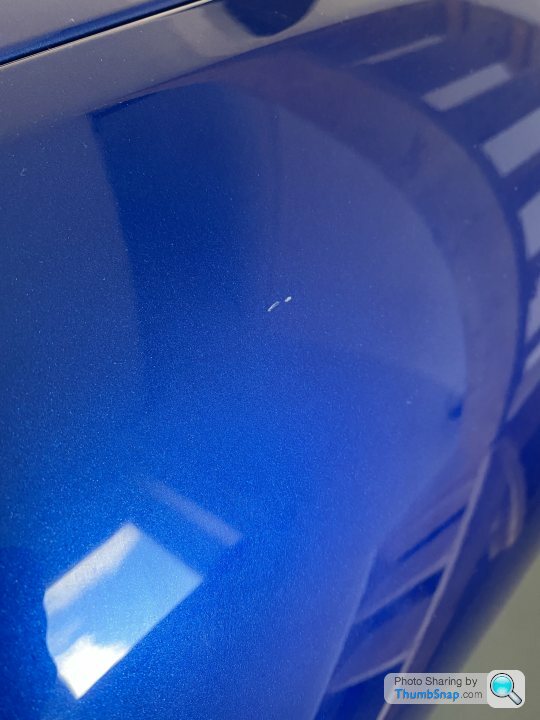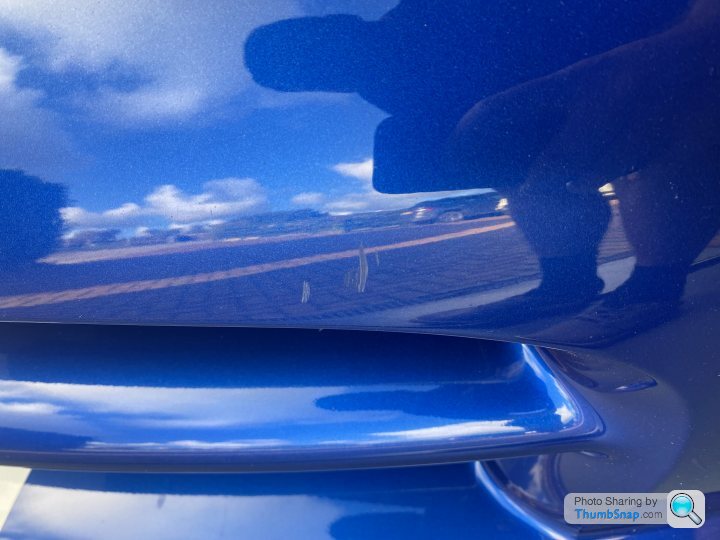Dodge viper - as new - stone chips - paint or detail?
Discussion
Hi Guys,
I have a 2006 dodge viper SRT coupe with only 2,000 miles on it, always garaged and never seen rain, so it is obviously pretty mint overall.
However the soft paint and composite body LOVES stone-chips and small scapes, and they are hardly noticeable, but bug me on an otherwise Concours car.
Whats my options, can they be Smart repaired? Will it need a paint blowover? or could a good detailer mitigate them?
Ta
I have a 2006 dodge viper SRT coupe with only 2,000 miles on it, always garaged and never seen rain, so it is obviously pretty mint overall.
However the soft paint and composite body LOVES stone-chips and small scapes, and they are hardly noticeable, but bug me on an otherwise Concours car.
Whats my options, can they be Smart repaired? Will it need a paint blowover? or could a good detailer mitigate them?
Ta
Stone chips.
Perfect is a panel respray.
The old SMART repair used solvent based base coat & a thin clear applied with airbrushes. The overspray then removed by wiping over with a solvent chemical but that tended to remove everything from larger chips. Took the 'eye' off them & popular with used car dealers for that reason but that was as good as it got.
With the switch to waterbased that option went.
Touching in using a toothpick/mig wire/straightened out paper clip will achieve much the same result but some colours esp pale metallics need care as putting too much paint in will make the chip look dark.
FWIW in the days of the solvent Vauxhall Star Silver 3 worked well on a lot of silvers (not just Vauxhall) but I don't know if that would still work. It's a light silver & for some reason worked very well even though it didn't match the bodywork.
Search & you'll find various posts on PH of people who say they've touched in chips with one of the various kits & have built it up then sanded it smooth & level with the surface before polishing.
Never tried it & sanding the bonnet isn't a good idea as you don't know how thick the existing paint is & if you go through the clearcoat to the base then it's game over & bonnet respray time. If a car has been sanded to remove orange peel (is that 'paint correction'?) then there's even less margin for error.
Scuffs & scrapes
On clear over base it might polish out.
Wet the damage & if it seems to disappear then the damage is probably only in the clear coat & polishing might improve it as it will smooth out the damage to the clearcoat surface. Best not to try & sand flat as you might go through the clearcoat.
If it doesn't seem to disappear when wet then it's paint time.
SMART repair or bodyshop is up to you. Before we get the usual bleating some SMART repairers are very good, some bodyshops are poor. Best to seek recommendations from those who have had work done by your chosen repairer.
Bear in mind the risk of colour mismatch - even with an eyematch - if you're having paintwork done & the potential need to blend into adjacent panels.
Perfect is a panel respray.
The old SMART repair used solvent based base coat & a thin clear applied with airbrushes. The overspray then removed by wiping over with a solvent chemical but that tended to remove everything from larger chips. Took the 'eye' off them & popular with used car dealers for that reason but that was as good as it got.
With the switch to waterbased that option went.
Touching in using a toothpick/mig wire/straightened out paper clip will achieve much the same result but some colours esp pale metallics need care as putting too much paint in will make the chip look dark.
FWIW in the days of the solvent Vauxhall Star Silver 3 worked well on a lot of silvers (not just Vauxhall) but I don't know if that would still work. It's a light silver & for some reason worked very well even though it didn't match the bodywork.
Search & you'll find various posts on PH of people who say they've touched in chips with one of the various kits & have built it up then sanded it smooth & level with the surface before polishing.
Never tried it & sanding the bonnet isn't a good idea as you don't know how thick the existing paint is & if you go through the clearcoat to the base then it's game over & bonnet respray time. If a car has been sanded to remove orange peel (is that 'paint correction'?) then there's even less margin for error.
Scuffs & scrapes
On clear over base it might polish out.
Wet the damage & if it seems to disappear then the damage is probably only in the clear coat & polishing might improve it as it will smooth out the damage to the clearcoat surface. Best not to try & sand flat as you might go through the clearcoat.
If it doesn't seem to disappear when wet then it's paint time.
SMART repair or bodyshop is up to you. Before we get the usual bleating some SMART repairers are very good, some bodyshops are poor. Best to seek recommendations from those who have had work done by your chosen repairer.
Bear in mind the risk of colour mismatch - even with an eyematch - if you're having paintwork done & the potential need to blend into adjacent panels.
Edited by paintman on Wednesday 16th November 12:46
Very nice.
Touch in the chips.
The bumper scuff would need filler & paint.
I don't think a smart type repair is suitable due to the location & the bumper would need respraying for it to be invisible.
Chances are for the latter you'd get away with a half bumper spray using the white stripes as the edge.
You could try colouring it in using a fine brush but leaving the damage as is.
MIGHT make a difference to a casual observer not looking closely but it's always going to be noticeable - esp to you as you will always look at it when you go to the car!
Touch in the chips.
The bumper scuff would need filler & paint.
I don't think a smart type repair is suitable due to the location & the bumper would need respraying for it to be invisible.
Chances are for the latter you'd get away with a half bumper spray using the white stripes as the edge.
You could try colouring it in using a fine brush but leaving the damage as is.
MIGHT make a difference to a casual observer not looking closely but it's always going to be noticeable - esp to you as you will always look at it when you go to the car!
Yeh I’m wondering if front bumper and side sill re spray as they take the brunt of the damage
Then smart repair the small stone chips elsewhere
That would be a pretty good middle ground with best results.
The white stripes are vinyl, what does this mean for a bumper respray? Need to come off and be replaced, or paint around them?
Then smart repair the small stone chips elsewhere
That would be a pretty good middle ground with best results.
The white stripes are vinyl, what does this mean for a bumper respray? Need to come off and be replaced, or paint around them?
Number of options, first two being for damage to one side of the bumper.
Paint half the bumper leaving the vinyl in situ, mask & use it as the edge.
Remove one vinyl, paint half the bumper so the edge of the new clearcoat finishes where the vinyl would cover it & fit a new stripe covering the join.
Remove the vinyl altogether, paint the whole bumper, fit new stripes.
Paint half the bumper leaving the vinyl in situ, mask & use it as the edge.
Remove one vinyl, paint half the bumper so the edge of the new clearcoat finishes where the vinyl would cover it & fit a new stripe covering the join.
Remove the vinyl altogether, paint the whole bumper, fit new stripes.
When I got my Aston the front had some stone rash on the front and a couple of chips it only had 3k miles on it. I took it to my Bodyshop in Italy who looked and thought it might need paint which I really did not want. In the end they touched up the chips and then polished out all the rash it was the best job I have ever seen looked perfect and without spraying,
Find someone to do this imo better than putting new paint on such a low-mile car.
Find someone to do this imo better than putting new paint on such a low-mile car.
Gassing Station | Bodywork & Detailing | Top of Page | What's New | My Stuff







